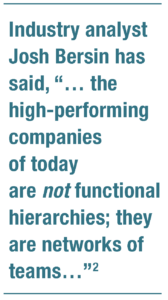Since the dawn of the computer age, industry pioneers knew that our new digital tools were only as good as they were usable. As technology became more sophisticated (and complicated), ease of use has become more elusive. Our software is meant to make one “more productive.”1 However, “knowledge worker productivity is inherently enigmatic and almost impossible to quantify.” At least we should strive to make work easier as we navigate an increasingly complex world.
In the consumer world, ease of use is a must. Our smartphones can be operated with minimal instruction, and soon, their functions feel natural. We understand that business software is inherently more complicated, and there will be a more substantial learning curve to start firing on all cylinders. Yet, even consumer technology usability[12] can be less than first-rate.
I want to start with an analogy in the consumer world relating to home entertainment. In the beginning, we had 13 channels of TV and UH, then cable took hold, and we had hundreds of channels and nothing to watch. People were unhappy paying for bundles of channels, the vast majority of which you will never tune into. Then, the market got fragmented: Netflix, Hulu, Amazon, Apple, and others with “smart[19]” TVs offered enhancements or even cable replacements. Navigating these options made it painful to search for a program in any way other than speech recognition.
The fragmentation is bordering on chaos:
- You have to authenticate with each provider. Sometimes, it forgets your credentials[7], and you have to reset them.
- You are offered several platforms to get the desired program. They are listed along with prices. Some are marked “free to me” because they are included in one of your subscriptions.
- Remotes – separate remotes are needed for the TV, cable box, and audio system.
If any of you have experienced this, you know that it is a horrible user experience[3]. Now there’s a trend back toward the bundled model[20], with some consolidation of the market.
The Vision
The best software fades into the background, and you don’t even know it’s there. This is the mantra we must live by when designing a user[21] experience. However, the user experience of your entertainment system, described above, is far from fading into the background.
We want a user experience where every aid and convenience is available to any worker anytime without impeding their focus on their task[22]. Let’s see what this entails:
- Information[8] is readily available – your question gets answered promptly, correctly, and with limited ambiguity.
- The user is unaware of what system is delivering information—the user doesn’t know (and shouldn’t care) what back-end system is performing the task.
- The system knows who you are and what you will likely want to do: interoperability[4] between systems and access to historical transactions for a seamless experience.
- Humans should be reserved for the most complex tasks; everything else should be automated. Automated apps should handle simple tasks or questions, with human experts reserved for complex issues.
- The system should proactively recognize and resolve issues or impediments to accomplishing the task: built-in workflows with robust exception processing.
- Systems interactions should be intuitive – users shouldn’t require training to accomplish their goals.
Surveys
The most direct way to get feedback from workers is to ask them. Surveys are considered an active method[23] of gaining information because you are actively eliciting information from the workers, as opposed to a passive approach whereby you use technology to record metrics[24] generated by the worker.
Surveys besiege us in our daily lives. You can hardly use any service without being asked to complete a survey. For the worker focused on their job, you’re asking them to pause working and complete the survey (so much for the software fading into the background).
Surveys can be helpful because they get right to the information you want to collect, but they depend on how the questions are worded and who you’re asking. Surveys can be valuable because they are leading indicators. However, if the information gathered by the study is not actioned immediately, the worker will lose confidence in the survey, affecting future participation.
Survey vendors assure the employees’ anonymity and only allow the export of aggregated data[25]. That means you must consider the dimensions you want to report on before exporting the information.
The passive approach involves using technology to capture helpful information without the worker interrupting their work to complete a survey. Organizational Network Analysis (ONA) does just that—it looks at data in the enterprise (e.g., calls, texts, emails, etc.) to establish who is interacting in the workplace. Sentiment analysis[1] uses statistical techniques to determine workers’ feelings based on the language in their texts and emails.
The Role of Artificial Intelligence (AI)
AI[31] and worker experience were made for each other. Conventional technology can effectively provide one with information or take them through a transaction[13], but AI can provide much more. Imagine being accompanied by a digital coach who provides you with answers, information, or advice at the moment it’s needed.
A common use case[14] for AI is Chatbots. Simple, commonplace chatbots will narrow down the reason for the inquiry and point you to an applicable link or a human expert if the query[26] cannot be resolved. As the technology evolves, chatbots can potentially replace human help agents as they can deal with more nuanced understanding and, therefore, save significant money.
The net result is the enhanced or augmented worker.
Agile Organizations

Industry analyst Josh Bersin has said, “… the high-performing companies of today are not functional hierarchies; they are networks of teams…” 2 The agile methods require team leads to have a way to quickly create, disband, and modify teams that reflect the way work gets done. I call this Distributed Ownership.
Yet HR software still represents the organizational structure as hierarchies. This limits transactional workflow[15] approvals, reporting/analytics[16], and access security[17]. Sure, you can designate a matrix relationship, but this is maintained centrally by a system administrator (rather than distributed ownership), quickly becoming unmanageable in an ecosystem[18] of teams and relationships in the organization.
What’s Behind the Curtain?
Making work simple for workers is a complicated task. Behind the scenes, a great deal of technology enables a positive user experience.
The Data/Integration Platform
Data is at the root of it – all applications need to “know” about the user we’re interacting with. Integrations need to make a seamless transition between functions. Think of integrations as “connective tissue” between the person’s organs. You cannot live without it. Most integrations are point-to-point, for instance, between your HRIS[27] and Applicant Tracking System. Suppose your system architecture[9] is based on a platform containing all your people data. In that case, it makes more sense for the integrations to be between each application[10] and the data platform, which would ensure that you’re sharing between applications the latest and most correct version of your data and that it’s being kept up to date with the other systems.
- Once your data is imported into the platform, it must be cleaned up. Our systems often contain a lot[32] of incomplete or incorrect data. The Human Resource Business Partners can help reach out to the workers and correct or complete missing or suspected data.
- Often, a person’s unique identifier is not consistent among systems. For example, your payroll system, HRIS, finance system, etc., may have different identifying primary keys. Data harmonization is getting all the systems to talk to each other.
- Once the data is complete, corrected, and harmonized, it can be normalized, kept in the optimal format for maintaining changes, and de-normalized: put in a format easily accessible for analytics or integrations (called a Star Schema[28]).
- Finally, we need to agree on what the data means. For instance, a request for a listing of all employees can mean different things to different people. Depending on who’s asking, it can mean FTEs, positions (filled or empty), or workers, including consultants (or not). Data taxonomy stores commonly agreed descriptions of metrics.
- The data platform is an excellent place to put that app or data that doesn’t fit anywhere else. For instance, all those customizations of your pre-cloud on-premise system that you couldn’t replicate when you implemented your cloud[29] HRIS. Or the data structure to maintain the agile organizational relationships discussed earlier.
The platform is the best way to use analytics to get a holistic view of the workforce, and analytics should be central to your worker management strategy and workforce planning[2].
As AI is embedded in almost all of your applications, start by leveraging that capability where it aligns with your strategy. Once you gain a level of maturity, you can use the unstructured data stored in your data platform, e.g., texts, phone calls, images, etc., as the training dataset for machine learning[5] and the basis of your foray into AI.
Where to Get Started
The approach laid out here can be accomplished by creating a center of excellence around integrations, data management[6], AI, and usability. Consulting firms or other vendors dedicated to each of these disciplines can fill the gaps if needed.
Begin by compiling an inventory of applications and current integrations. Start cleaning up missing or incorrect data. Think about your pain points, what you want to get out of analytics and AI, and what processes you’d like to improve.
Conclusion
The Worker Experience Platform gives companies optimized flexibility in their technology stack. Not only does it support the best possible worker experience, but it goes beyond the worker experience as it optimizes future HR technology[11] initiatives by assembling your data in the ideal format, allows you to take control over your integrations, and gives you a platform that acts as means to fill the gaps between your HR modules. But it all comes down to trust – will your workforce trust the software that supports them? That trust is earned by being sensitive to workers’ needs and having a working toolset to act upon them.
ENDNOTES
2 https://www.fastcompany.com/3068492/the-future-of-work/how-ai-is-changing-the-way-companies-are-organized
The process of determining and analyzing the emotional tone or sentiment expressed in text or speech.
The assessment of the current workforce in order to predict future needs. This can consist of both demand planning and supply planning.
The experienced quality of an interactive system from the perspective of those directly using the system.
The ability of different systems, technologies, or software applications to seamlessly communicate, exchange data, and work together effectively.
An application of artificial intelligence (AI) that provides systems the ability to automatically learn and improve from experience without being explicitly programmed. The basic premise of machine learning is to build algorithms that can receive input data and use statistical analysis to predict an output while updating outputs as new data becomes available. A branch of artificial intelligence that enables computers to learn and improve from experience without being explicitly programmed.




